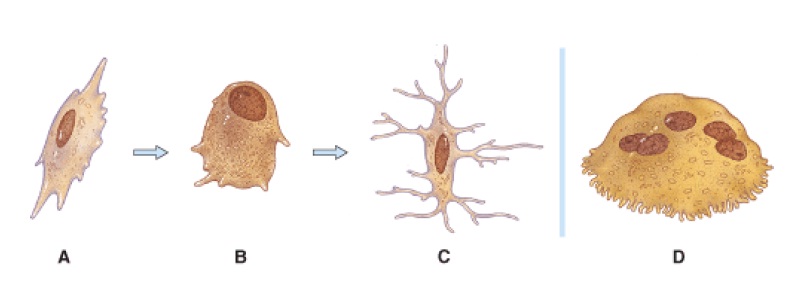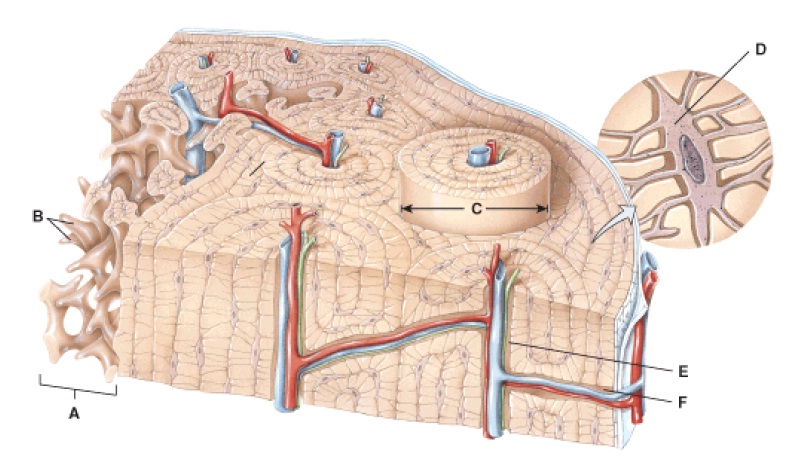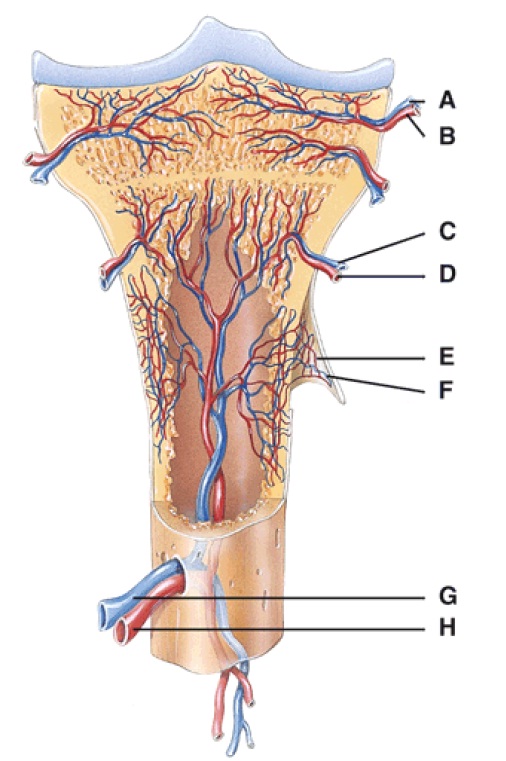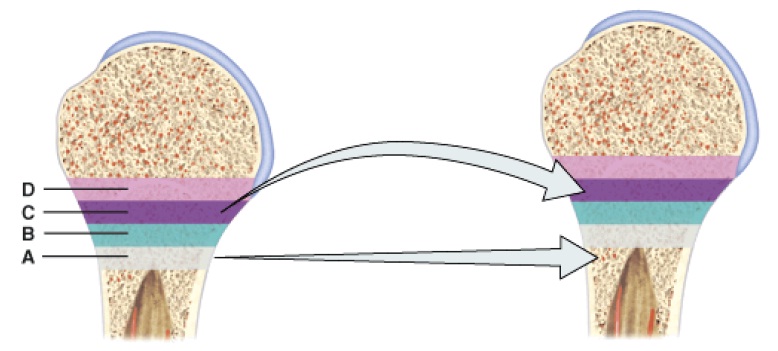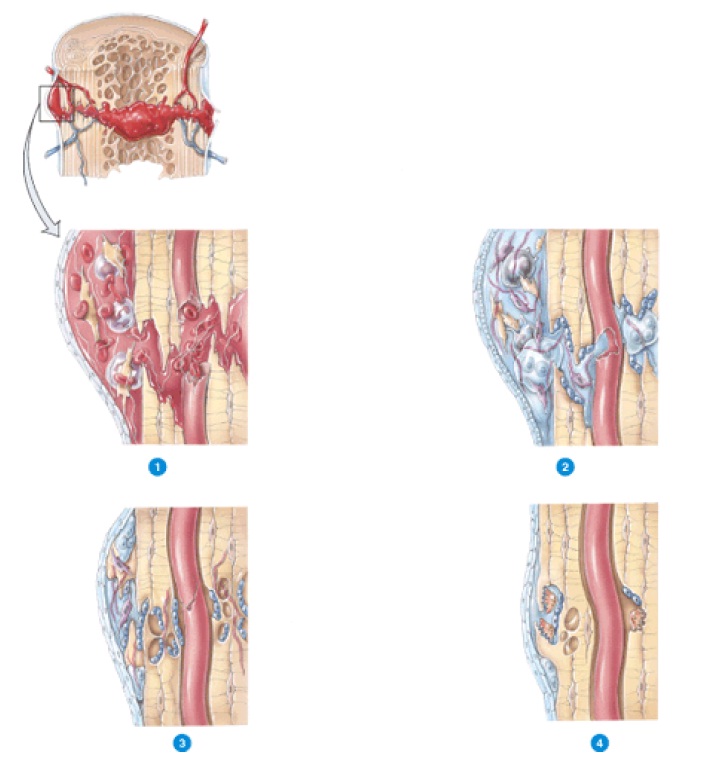Anatomy And Physiology Questions - The Skeletal System: Bone Tissue
(304).jpg)
Everything about bones in cellular level. Linked to the 'Childhood' case unit.
- 1.
This is a structure of a long bone that stores energy.
- A.
Diaphysis
- B.
Epiphysis
- C.
Metaphysis
- D.
Periosteum
- E.
Marrow
Correct Answer
E. MarrowExplanation
Marrow is the correct answer because it is the structure in a long bone that stores energy. Marrow is a soft, gelatinous tissue found in the center of bones, and it is responsible for producing red and white blood cells as well as storing fat. It plays a crucial role in the body's immune system and provides a source of energy for the body when needed.Rate this question:
-
- 2.
This is the region of a long bone that articulates with other bones.
- A.
Diaphysis
- B.
Epiphysis
- C.
Metaphysis
- D.
Periosteum
- E.
Marrow
Correct Answer
B. EpiphysisExplanation
The epiphysis is the correct answer because it is the region of a long bone that articulates with other bones. The epiphysis is the rounded end of a long bone, which connects to other bones to form joints. It is covered with articular cartilage, which allows for smooth movement and reduces friction between bones during articulation. The epiphysis also contains red bone marrow, which is responsible for producing blood cells.Rate this question:
-
- 3.
This is the shaft of a logn bone.
- A.
Diaphysis
- B.
Epiphysis
- C.
Metaphysis
- D.
Periosteum
- E.
Marrow
Correct Answer
A. DiaphysisExplanation
The diaphysis is the correct answer because it refers to the shaft of a long bone. The diaphysis is the long, cylindrical portion of the bone between the two ends, known as the epiphyses. It is primarily composed of compact bone tissue and contains the medullary cavity, which houses the bone marrow. The diaphysis provides support and strength to the bone, allowing for movement and weight-bearing.Rate this question:
-
- 4.
This is a lyaer of hyaline cartilage that reduces friction between bones involved in the joint.
- A.
Periosteum
- B.
Distal epiphysis
- C.
Nutrient foramen
- D.
Articular cartilage
- E.
Epiphyseal plate
Correct Answer
D. Articular cartilageExplanation
Articular cartilage is a layer of hyaline cartilage that reduces friction between bones involved in a joint. It provides a smooth and lubricated surface, allowing for smooth movement and cushioning the bones during joint articulation. This cartilage helps to distribute forces evenly across the joint, protecting the underlying bone and preventing wear and tear.Rate this question:
-
- 5.
This is a layer of hyaline cartilage that allows the diaphysis to grow in length.
- A.
Periosteum
- B.
Distal epiphysis
- C.
Nutrient foramen
- D.
Articular cartilage
- E.
Epiphyseal plate
Correct Answer
E. Epiphyseal plateExplanation
The epiphyseal plate is a layer of hyaline cartilage located at the ends of long bones. It allows for longitudinal growth of the diaphysis, or the shaft of the bone. As the bone grows, the cartilage in the epiphyseal plate is replaced by bone tissue, resulting in the lengthening of the bone. This process is essential for the growth and development of bones during childhood and adolescence.Rate this question:
-
- 6.
This is the region in mature bone where the diaphysis and the epiphysis join.
- A.
Epiphyseal plate
- B.
Epiphyseal line
- C.
Metaphysis
- D.
Diaphyseal line
- E.
Diaphyseal plate
Correct Answer
C. MetaphysisExplanation
The metaphysis is the correct answer because it is the region in mature bone where the diaphysis (shaft) and the epiphysis (end) join. It is a transitional zone between the two regions and is responsible for bone growth and lengthening during childhood and adolescence. The epiphyseal plate and line are also related to bone growth but are not specifically where the diaphysis and epiphysis join. The diaphyseal line and plate are not relevant to the question.Rate this question:
-
- 7.
This is a lining found in bone that promotes bone growth in width.
- A.
Periosteum
- B.
Endosteum
- C.
Marrow
- D.
Epiphysis
- E.
Metaphysis
Correct Answer
A. PeriosteumExplanation
The periosteum is a lining found in bone that promotes bone growth in width. It is a dense connective tissue membrane that covers the outer surface of bones, except at the joints. The periosteum contains blood vessels, nerves, and cells that are involved in bone formation and repair. It plays a crucial role in providing nutrients and oxygen to the bone cells, as well as in the healing of fractures.Rate this question:
-
- 8.
Put the bone cells in order of their maturation from unspecialised to specialised.
- A.
Osteoblast, osteogenic, osteocytes
- B.
Osteogenic, osteoblast, osteocytes
- C.
Osteogenic, osteocytes, osteoblast
- D.
Osteoblast, osteocytes, osteogenic
- E.
None of the above
Correct Answer
B. Osteogenic, osteoblast, osteocytesExplanation
Bone cells undergo a process of maturation, starting from unspecialized cells to specialized cells. The correct order of maturation is osteogenic, osteoblast, and osteocytes. Osteogenic cells are undifferentiated cells that have the ability to differentiate into osteoblasts. Osteoblasts are responsible for the synthesis and secretion of bone matrix. Osteocytes are mature bone cells that are derived from osteoblasts and are embedded within the bone matrix. Therefore, the correct order of maturation from unspecialized to specialized bone cells is osteogenic, osteoblast, osteocytes.Rate this question:
-
- 9.
These are considered bone-building cells.
- A.
Osteogenic
- B.
Osteoclast
- C.
Osteocytes
- D.
Osteoblasts
- E.
All of the above
Correct Answer
D. OsteoblastsExplanation
Osteoblasts are cells responsible for building and repairing bones. They synthesize and secrete proteins and other components that form the extracellular matrix of bone tissue. Osteoblasts play a crucial role in bone development and growth, as well as in the repair of fractures and the remodeling of bone. They are involved in the process of bone mineralization by depositing minerals, such as calcium and phosphate, onto the matrix. Therefore, osteoblasts are considered bone-building cells.Rate this question:
-
- 10.
These are considered bone-dissolving cells.
- A.
Osteogenic
- B.
Osteoclast
- C.
Osteocytes
- D.
Osteoblasts
- E.
All of the above
Correct Answer
B. OsteoclastExplanation
Osteoclasts are considered bone-dissolving cells. They are responsible for breaking down and resorbing bone tissue. Osteoclasts play a crucial role in bone remodeling and maintaining bone health. They are derived from monocytes and are multinucleated cells that secrete enzymes and acids to dissolve the mineralized matrix of bone. Their activity is regulated by various factors, such as hormones and cytokines. Osteoclasts are essential for the balance between bone resorption and formation, and any disruption in their function can lead to bone diseases like osteoporosis.Rate this question:
-
- 11.
Which of the following structures contains osteocytes?
- A.
Haversian
- B.
Volkmann's
- C.
Concentric
- D.
Lacunae
- E.
Canaliculi
Correct Answer
D. LacunaeExplanation
Lacunae is the correct answer because it refers to small spaces or cavities within the bone matrix where osteocytes are located. Osteocytes are bone cells that are responsible for maintaining the health and integrity of the bone tissue. They are found within the lacunae and are connected to each other and to the blood supply through tiny channels called canaliculi. The Haversian and Volkmann's canals are channels in the bone that contain blood vessels and nerves, while concentric refers to the layers of bone tissue surrounding the Haversian canals.Rate this question:
-
- 12.
These are extensions of the lacunae and are filled with extracellular fluid.
- A.
Volkmann's canals
- B.
Haversian canals
- C.
Osteons
- D.
Canaliculi
- E.
Periosteum
Correct Answer
D. CanaliculiExplanation
Canaliculi are small channels or canals that connect the lacunae of bone tissue. They are filled with extracellular fluid, which allows for the exchange of nutrients and waste products between osteocytes (bone cells) and the blood vessels in the Haversian canals. Canaliculi play a crucial role in maintaining the health and function of bone tissue by facilitating communication and nutrient exchange between cells.Rate this question:
-
- 13.
Osteons in compact bone tissues are aligned along
- A.
Horizontal to the metaphysis
- B.
Parallel to the epiphysis
- C.
Lines of stress
- D.
Randomly between the epiphyseal plate
- E.
Parallel to blood vessels
Correct Answer
C. Lines of stressExplanation
The correct answer is "Lines of stress." Osteons in compact bone tissues are aligned along lines of stress to provide strength and support to the bone. This alignment helps to distribute the forces and stresses experienced by the bone during weight-bearing activities, reducing the risk of fractures or damage.Rate this question:
-
- 14.
Bone remodelling does NOT
- A.
Occur throughout life
- B.
Involve bone resorption
- C.
Involve bone deposition
- D.
Occur at different rates at different locations
- E.
Affect compact bone tissue but does affect spongy bone tissue
Correct Answer
E. Affect compact bone tissue but does affect spongy bone tissueExplanation
Bone remodeling is a continuous process that occurs throughout life. It involves both bone resorption, which is the breaking down of old bone tissue, and bone deposition, which is the formation of new bone tissue. Bone remodeling also occurs at different rates at different locations in the body. While it affects both compact and spongy bone tissue, the statement suggests that it does not affect compact bone tissue but does affect spongy bone tissue.Rate this question:
-
- 15.
The renewal rate for compact bone tissue is
- A.
4% per year
- B.
15% per year
- C.
20% per year
- D.
25% per year
- E.
10% per year
Correct Answer
A. 4% per yearExplanation
The renewal rate for compact bone tissue is 4% per year. This means that 4% of the compact bone tissue is replaced with new tissue every year. This process of renewal helps to maintain the strength and integrity of the bone. It allows for the removal of old or damaged tissue and the formation of new tissue, ensuring that the bone remains healthy and functional.Rate this question:
-
- 16.
Which of the following minerals is needed when bones are growing?
- A.
Chlorine
- B.
Sulphur
- C.
Magnesium
- D.
Chlorine and sulphur
- E.
Chlorine, sulphur and magnesium
Correct Answer
C. MagnesiumExplanation
Magnesium is needed when bones are growing because it plays a crucial role in bone formation and maintenance. It helps in the absorption and metabolism of calcium, which is essential for bone health. Magnesium also contributes to the production of collagen, a protein that provides structure to bones. Additionally, magnesium aids in the regulation of vitamin D, which is necessary for calcium absorption. Therefore, a sufficient intake of magnesium is necessary for proper bone growth and development.Rate this question:
-
- 17.
The correct sequence of processes that occur during bone elongation at the epiphyseal plate are:
- A.
Calcification, resting, proliferation, hypertrophication
- B.
Resting, proliferation, calcification, hypertrophication
- C.
Proliferation, resting, hypertrophication, calcification
- D.
Resting, proliferation, hypertrophication, calcification
- E.
Hypertrophication, calcification, proliferation, resting
Correct Answer
D. Resting, proliferation, hypertrophication, calcificationExplanation
During bone elongation at the epiphyseal plate, the first step is resting. This is when the chondrocytes in the epiphyseal plate are not actively dividing. The next step is proliferation, where the chondrocytes undergo rapid cell division and form stacks of cells. After proliferation, the chondrocytes undergo hypertrophication, where they enlarge and mature. Finally, calcification occurs, where the chondrocytes mineralize and form bone tissue. Therefore, the correct sequence of processes is resting, proliferation, hypertrophication, and calcification.Rate this question:
-
- 18.
During adulthood, which of the following does NOT contribute to bone remodeling and growth?
- A.
Calcium
- B.
Vitamins
- C.
Enzymes
- D.
Sex hormones
- E.
Human growth hormone
Correct Answer
C. EnzymesExplanation
Enzymes do not contribute to bone remodeling and growth during adulthood. While calcium, vitamins, sex hormones, and human growth hormone all play important roles in bone health and growth, enzymes do not have a direct impact on bone remodeling. Enzymes are proteins that catalyze chemical reactions in the body, but they are not directly involved in the processes that regulate bone growth and remodeling.Rate this question:
-
- 19.
This type of fracture is considered a partial fracture and is usally seen in children.
- A.
Open
- B.
Comminuted
- C.
Impacted
- D.
Greenstick
- E.
Stress
Correct Answer
D. GreenstickExplanation
Greenstick fractures are considered partial fractures because they involve a crack or bend on one side of the bone while the other side remains intact. This type of fracture is commonly seen in children because their bones are more flexible and less brittle compared to adults. The term "greenstick" refers to the analogy of trying to break a green, flexible stick which tends to bend rather than snap completely.Rate this question:
-
- 20.
About 25% of all stress fractures involve which bone?
- A.
Rib
- B.
Clavicle
- C.
Humerus
- D.
Ulna
- E.
Tibia
Correct Answer
E. TibiaExplanation
About 25% of all stress fractures involve the tibia. Stress fractures are small cracks or breaks in the bone that occur due to repetitive stress or overuse. The tibia, also known as the shinbone, is one of the most common sites for stress fractures. It is a weight-bearing bone located in the lower leg, and activities that involve repetitive impact, such as running or jumping, can put stress on the tibia and lead to fractures. Therefore, it is likely that about 25% of all stress fractures involve the tibia.Rate this question:
-
- 21.
Bone reduction
- A.
Is the alignment of epiphyseal plates
- B.
Can be open or closed
- C.
Is followed by a period of mobilisation
- D.
Is the alignment of epiphyseal plates and can be open or closed
- E.
All of the above
Correct Answer
B. Can be open or closedExplanation
Bone reduction refers to the process of realigning fractured bones. It can be either an open reduction, where surgery is required to realign the bones, or a closed reduction, where the bones are manually manipulated back into their proper position without surgery. After bone reduction, a period of mobilization is necessary to allow for healing and restoration of normal function. Therefore, the correct answer is that bone reduction can be open or closed.Rate this question:
-
- 22.
Bone mass reduction is promoted by which hormone?
- A.
Calcitriol
- B.
Calcitonin
- C.
Human growth hormone
- D.
Parathyroid
- E.
Insulin
Correct Answer
D. ParathyroidExplanation
Parathyroid hormone (PTH) is responsible for promoting bone mass reduction. PTH increases the release of calcium from the bones into the bloodstream, which helps maintain the calcium balance in the body. This hormone stimulates the activity of osteoclasts, which are cells that break down bone tissue, leading to a reduction in bone mass. Therefore, the correct answer is Parathyroid.Rate this question:
-
- 23.
An increase in bone growth is promoted by which hormones?
- A.
Calcitriol and human growth hormone
- B.
Calcitonin and calcitriol
- C.
Human growth hormone and parathyroid
- D.
Parathyroid and insulin
- E.
Insulin and human growth hormone
Correct Answer
B. Calcitonin and calcitriolExplanation
Calcitonin and calcitriol are the hormones that promote an increase in bone growth. Calcitonin helps to regulate calcium levels in the blood and prevents the breakdown of bone tissue. Calcitriol, the active form of vitamin D, aids in the absorption of calcium and phosphate from the intestines, which is essential for bone growth and remodeling. Together, these hormones work to maintain bone health and stimulate bone growth.Rate this question:
-
- 24.
Where in the diagram is the distal epiphysis?
- A.
A
- B.
B
- C.
C
- D.
D
- E.
E
Correct Answer
D. D -
- 25.
Where in the diagram can you find red bone marrow in an adult?
- A.
A and B
- B.
B and D
- C.
A and D
- D.
C
- E.
E
Correct Answer
C. A and DExplanation
Red bone marrow is found in the spongy bone tissue of certain bones in the body. In adults, red bone marrow is mainly found in the vertebrae, ribs, sternum, and the ends of long bones such as the femur and humerus. Option A includes the vertebrae and option D includes the ends of long bones, which are both correct locations for red bone marrow in an adult. Therefore, the correct answer is A and D.Rate this question:
-
- 26.
Where in the diagam is the metaphysis?
- A.
A
- B.
B
- C.
C
- D.
D
- E.
E
Correct Answer
B. BExplanation
The metaphysis is located in area B of the diagram.Rate this question:
-
- 27.
Where in the diagram is the only place not to have a periosteum?
- A.
A
- B.
B
- C.
C
- D.
D
- E.
E
Correct Answer
E. E -
- 28.
Which of the following cells starts forming the bone matrix?
- A.
A
- B.
B
- C.
C
- D.
D
Correct Answer
B. BExplanation
Cell B starts forming the bone matrix.Rate this question:
-
- 29.
Which of the following cells is an osteoclast?
- A.
A
- B.
B
- C.
C
- D.
D
Correct Answer
D. D -
- 30.
Which of the following cells helps the most to maintain bone tissue?
- A.
A
- B.
B
- C.
C
- D.
D
Correct Answer
C. CExplanation
Cell C, also known as osteoblasts, helps the most in maintaining bone tissue. Osteoblasts are responsible for synthesizing and depositing new bone material, which helps in bone formation and repair. They play a crucial role in the continuous remodeling and growth of bones. Osteoblasts produce collagen and other proteins necessary for bone formation, and they also regulate the mineralization process. Without the activity of osteoblasts, bone tissue would not be able to maintain its strength and structure.Rate this question:
-
- 31.
Which of the following cells is an osteogenic cell?
- A.
A
- B.
B
- C.
C
- D.
D
Correct Answer
A. AExplanation
An osteogenic cell is a type of stem cell that is responsible for the formation of new bone tissue. It has the ability to differentiate into osteoblasts, which are the cells that produce bone. Therefore, the correct answer is A, as it is the only cell listed that has the potential to become an osteoblast and contribute to bone formation.Rate this question:
-
- 32.
In the diagram, where is the Haversian canal?
- A.
C
- B.
A
- C.
E
- D.
F
- E.
D
Correct Answer
C. EExplanation
The Haversian canal is located at position E in the diagram.Rate this question:
-
- 33.
In the diagram, where is the Volkman's canal?
- A.
A
- B.
B
- C.
C
- D.
E
- E.
F
Correct Answer
E. FExplanation
The Volkman's canal is located at position F in the diagram.Rate this question:
-
- 34.
In the diagram, where is the osteon?
- A.
A
- B.
B
- C.
C
- D.
D
- E.
E
Correct Answer
C. CExplanation
The osteon is located at position C in the diagram. The osteon is a fundamental structural unit of compact bone tissue, consisting of concentric layers of bone matrix called lamellae surrounding a central canal called the Haversian canal. This structure provides strength and support to the bone.Rate this question:
-
- 35.
In the diagram, where is the trabeculae?
- A.
B
- B.
C
- C.
D
- D.
E
- E.
F
Correct Answer
A. BExplanation
The trabeculae are located at position B in the diagram.Rate this question:
-
- 36.
In the diagram which of the following vessels supply the periosteum?
- A.
A and B
- B.
B and C
- C.
C and D
- D.
D and E
- E.
E and F
Correct Answer
E. E and F -
- 37.
In the diagram, where is the epiphyseal vein?
- A.
A
- B.
B
- C.
C
- D.
D
- E.
E
Correct Answer
A. A -
- 38.
In the diagram, where is the nutrient artery?
- A.
D
- B.
E
- C.
F
- D.
G
- E.
H
Correct Answer
E. HExplanation
Based on the given information, the nutrient artery is located at point H in the diagram.Rate this question:
-
- 39.
In the diagram, where is the zone of hypertrophic cartilage?
- A.
A
- B.
B
- C.
C
- D.
D
Correct Answer
B. BExplanation
The zone of hypertrophic cartilage is located at position B in the diagram. This is because the hypertrophic zone is the region where chondrocytes undergo hypertrophy and increase in size, preparing for ossification. In this zone, the cartilage cells are larger and more mature compared to the other zones.Rate this question:
-
- 40.
In the diagram, this zone contains dead chondrocytes with a calcified matrix.
- A.
A
- B.
B
- C.
C
- D.
D
Correct Answer
A. AExplanation
Based on the information given, the zone that contains dead chondrocytes with a calcified matrix is represented by option A in the diagram.Rate this question:
-
- 41.
In the diagram, where is the zone of resting cartilage?
- A.
A
- B.
B
- C.
C
- D.
D
Correct Answer
D. DExplanation
The zone of resting cartilage is located in D.Rate this question:
-
- 42.
Which of the following correctly describes what is happening above?
- A.
Fracture haematoma formation - fibrocartilaginous callus formation - bony callus formation - bone remodeling
- B.
Bone remodeling - fracture haematoma formation - fibrocartilaganous callus formation - bony callus formation
- C.
Fracture haematoma formation - bony callus formation - fibrocartilaginous callus formation - bone remodeling
- D.
Fibrocartilaginous callus formation - fracture haematoma formation - bony callus formation - bone remodeling
- E.
Fracture haematoma formation - bone remodeling - bony callus formation - fibrocartilaginous callus formation
Correct Answer
A. Fracture haematoma formation - fibrocartilaginous callus formation - bony callus formation - bone remodelingExplanation
Fracture haematoma formation is the first step in the bone healing process, where blood vessels are ruptured and a blood clot forms at the site of the fracture. This is followed by fibrocartilaginous callus formation, where fibroblasts and chondroblasts produce collagen and cartilage to stabilize the fracture. Bony callus formation then occurs, where osteoblasts produce new bone tissue to bridge the fracture gap. Finally, bone remodeling takes place, where excess bone is resorbed and the bone is reshaped to its original form.Rate this question:
-
- 43.
Which of the following organs is responsible for the production of bile, which aids in the digestion of fats?
- A.
Liver
- B.
Pancreas
- C.
Gallbladder
- D.
Small intestine
Correct Answer
C. GallbladderExplanation
The liver is the organ responsible for the production of bile. Bile is a greenish-yellow fluid that is stored in the gallbladder and released into the small intestine when needed to aid in the digestion and absorption of fats.Rate this question:
-
Quiz Review Timeline +
Our quizzes are rigorously reviewed, monitored and continuously updated by our expert board to maintain accuracy, relevance, and timeliness.
-
Current Version
-
Mar 12, 2024Quiz Edited by
ProProfs Editorial Team -
Apr 17, 2012Quiz Created by
Hermine0817
 Back to top
Back to top




